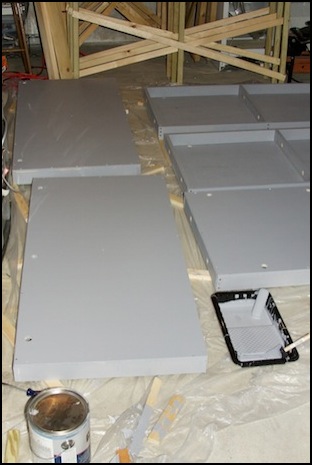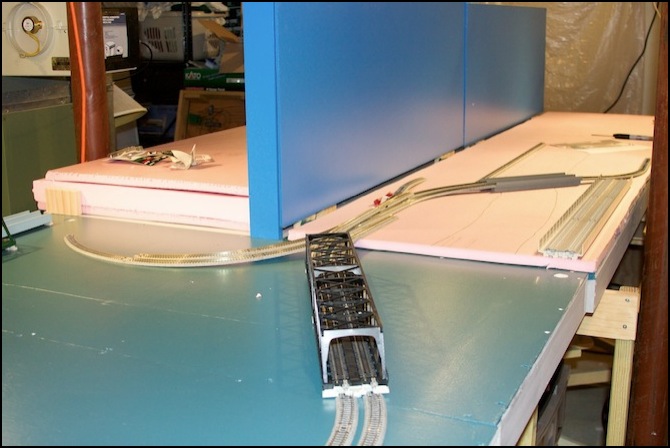Painting Wood
Many model railroad layouts are built atop a supporting structure of unpainted wood. Mine uses unpainted legs, but the actual supporting "tables" are painted. Why did I do it, and what did I learn from this?
The basic issue is expansion and contraction due to humidity. While I don't live in the most humid of environments, the basement goes from about 20% humidity in the dead of winter to 80%+ during summer rainstorms, and often changes by 20-30% in a day. Wood exposed to humid air absorbs water, and swells, wood exposed to dry air dries out and shrinks. And other materials, like insulation foam, don't.
In a layout built with "hardshell" scenery (plaster cloth laid over cardboard or insulation foam, all supported by a few spars of wood) there isn't all that much wood relative to the scenery. There's some risk the wood will change shape in a way that could affect the scenery, but it's minor. But I'm gluing sheets of foam directly onto wood (plywood actually, and that does matter somewhat). If the wood changes shape and the foam doesn't, the foam might break due to stress within it.
Now since I'm using plywood, there's less to be concerned with than if I was using planks of wood, as plywood is wood in different orientations glued together, which tends to limit it's shape changing due to humidity. I probably could get away without painting it, but painting was fairly easy so I decided to err on the safe side.
A second reason for paint is that in parts of my layout (the river) the scenery is the wood itself, and I didn't want the wood grain to show.
Primer
I started by applying a coat of "primer". This is a highly opaque paint that hides wood grain well. I used an interior latex designed for going under dark colors, Glidden Gripper Gray. Latex paints are good because you can clean up with water, and the fumes are relatively mild (and fumes from my basement tend to fill the house, so that's important). I did work with an open window to air the basement out (the weather was mild at the time), but there isn't really much airflow through the basement, so that was of limited use.
I applied this using a six-inch polyurethane foam "trim roller", which uses a minimum amount of paint and makes a very smooth surface. For the underside of the tables, I painted corners and other places the roller wouldn't reach with a disposable brush. I did this painting after the tables were built, but before they were installed, so I could flip them over after the top was dry to paint the underside.
In all cases I wore disposable nitrile gloves and wore a respirator. Latex is pretty safe stuff, but I still prefer to keep it outside my skin.
Although this is a good primer, one coat doesn't hide wood grain. For the underside one was enough to seal the wood, but on the top where I planned to paint water, I applied a second coat about an hour after the first. This particular paint can be recoated once it's dry, within a couple of hours, but after that you need to wait a day for the paint to cure.

Paint has an interesting characteristic: it "dries to touch" quickly, but it doesn't fully dry ("cure") for days (or weeks in some cases). This is because while the chemicals that make it liquid (water, and other things) mostly evaporate quickly, some are left behind, and it takes a long time for them all to get out.
A result of this is that you can re-coat paint for a time after the "dry to touch" stage while the paint is still damp enough to bond well to more paint, but after that you need to let it fully dry, and the new layer of paint can actually damage the old one if you don't wait. I did wait for the primer to cure before adding color coats, although I don’t think that’s required and I could probably have applied them once it was dry to touch. With this particular primer curing essentially happened in 24 hours (so if I didn’t add a coat once it was dry-to-touch, I could wait a day and add more coats or other colors). But with the finish paint I used above it, it took much longer.
Paint Me A River
After the primer was cured (weeks later, actually) I painted those areas that would have the appearance of water with a light green color. Maybe someday I'll do something fancier, like resin, but for now a semi-gloss paint meets my rather simple needs. The paint I used for this (Ralph Lauren semi-gloss latex, color: “Reflecting Pool”) was applied with the same kind of roller I'd used for the primer, and to ensure good coverage I did a minimum of two coats (actually I did three our four as I made a few mistakes and had to re-do large areas to get it smooth).

This paint took much longer to dry. I think I had to wait several hours before I could re-coat, and the paint actually took weeks to cure. Foam set atop it overnight two weeks later actually stuck hard enough to peel some chunks of foam off. I think it took nearly a month, in a relatively dry (not bone dry) season to stop being sticky.




